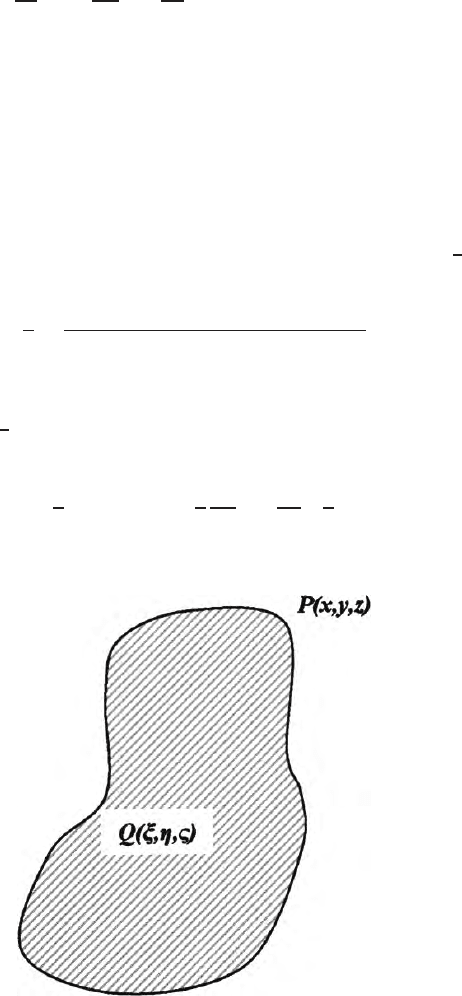Roy K.K. Potential theory in applied geophysics
Подождите немного. Документ загружается.


10.3 Corollaries of Green’s Theorem 309
10.3 Corollaries of Green’s Theorem
Some of the Corollaries of Green’s theorem are as follows:
Cor. 1 If φ and ψ are both harmonic and continuous within the region R,
then
φ
∂ψ
∂n
− ψ
∂φ
∂n
ds = 0 (10.9)
since both ∇
2
φ = ∇
2
ψ =0andφ and ψ satisfy Laplace equation.
Cor. 2 If φ is harmonic and continuously differentiable in a closed region then
the integral of the normal derivative of φ over the boundary vanishes.
If we put ψ =1, then
∂φ
∂n
ds = 0. (10.10)
This region do es not include any source. The surface integral of the normal
derivative of a harmonic function over any closed surface is zero.
Cor. 3 If a function φ is harmonic in a closed sphere of radius ‘a’ with the
centre at the point C, then φ
c
is equal to the average of its values on the
boundary surface. This is known as the mean value theorem or the average
value theorem in potential theory. If this theorem is applied in the case of
bodies of simpler geometrics, say, in the case of a sphere (Fig. 10.2) then for
a sphere, the normal is along the radial direction,
∂φ
∂n
=
∂φ
∂r
.Elementaryarea
ds = r
2
sin θ dθ dψ,whereθ and ψ are respectively the polar and azimuthal
angles.
Hence
∂φ
∂n
ds =
∂φ
∂n
r
2
sin θ dθ dψ
=
2π
0
π
0
∂φ
∂r
r
2
sin θ dθ dψ = 0 (10.11)
Fig. 10.2. A sphere of outer and inner radii ‘a’ and ‘r’ respectively

310 10 Green’s Theorem in Potential Theory
Multiplying both the sides of (10.11) by dr and integrating with in the region,
we get
=
r
0
dr
2π
0
π
0
∂φ
∂r
r
2
sin θ dθ dψ =0
⇒
2π
0
π
0
(φ
r
− φ
0
)r
2
sin θ dθ dψ =0
⇒
2π
0
π
0
φ
r
r
2
sin θ dθ dψ − 4πr
2
φ (c) = 0
⇒ φ
c
=
1
4πr
2
2π
0
π
0
φ
r
r
2
sin θ dθ dφ
=
1
4πr
2
2π
0
π
0
φ
r
ds
=
1
4πr
2
φ
s
ds. (10.12)
This gives the value of the potential at the centre which is the average of its
potential on the surface i.e., the mean value theorem is
φ
c
=
1
S
s
φ
s
ds (10.13)
Cor. 4 If a function φ is harmonic in a closed sphere, then φ
c
at the centre
is equal to the average of its value through out the sphere. This is the second
average value or mean value theorem.
From (10.12), we can write
a
0
φ
c
4πr
2
dr =
a
0
s
φ dsdr =
ν
φ dν (10.14)
where a is the radius of the sphere. Therefore
⇒ φ
c
=
1
ν
ν
φ dν. (10.15)
Here the sphere considered is a solid sphere and ν is the volume of the sphere.
Cor. 5 If φ is a harmonic function and not constant in a closed region, then
φ cannot have maximum or minimum inside the regio n.

10.4 Regular Function 311
Cor. 6 A maximum or a minimum value of a harmonic function occurs only
at a boundary of the region.
Cor. 7 If a function is harmonic in a region and is constants on the surface,
then it is constant throughout the region.
Cor. 8 Two functions φ and ψ which are harmonic in a region and are equal
at every point in the boundary are equal at every point in the region.
Cor. 9 If a solution of Laplace equation is found and has prescribed values
on the boundary, then the solution is un iq u e. This is known as the uniqueness
theorem in potential theory.
Cor. 10 If a function is harmonic in a closed region and its normal derivatives
vanish in the boundary, then the function is constant throughout the region.
Cor. 11 If two functions are harmonic in a closed region and have the same
normal derivative at the boundary, then they differ by a constant.
10.4 Regular Function
The space outside the closed volume (Fig. 10.1) is called the infinite region
where r →∞. If there be any function φ such that Lim
r→∞
rφ = finite or
Lim
r→∞
rgradφ = finite then φ is called a regular function at infinity. A potential
function is a regular function provided the source do es not exist in the region.
Cor. 12 A function is harmonic in an infinite region if it has continuous
second derivative, satisfies Lapla ce equation and is regular at infini ty.
With this definition of the harmonic and regular function, the theorem,
which we get is valid for infinite region. For an infinite region, the value
of a harmonic function is uniquely determined by the values of the normal
derivatives at the boundary.
Cor. 13 If φ and ψ are harmonic functions within a closed surface S and ψ
has a single pole on S so that
ψ =
1
r
+ ρ
where ρ is harmonic, then
φ (x, y, z)=
1
4π
s
ψ
∂ψ
∂n
− φ
∂φ
∂n
ds. (10.16)
Cor. 14 If φ and ψ are harmonic within a closed surface and φ and ψ have
single poles at ρ
1
and ρ
2
respectively and
φ =
1
r
1
+ ρ
1
and ψ =
1
r
2
+ ρ
2

312 10 Green’s Theorem in Potential Theory
then
1
4π
s
φ
∂ψ
∂n
− ψ
∂φ
∂n
ds = φ (ρ
1
) −ψ (ρ
2
) (10.17)
where φ(ρ
2
) is the value of the function φ at the p oint ρ
2
.
10.5 Green’s Formul a
Let a finite region R is bounded by the surface S. The point Q may be within
the volume or outside the region. The point P also may be within or outside
the region (Fig. 10.3). The coordinates of P and Q are respectively (x, y, z)
and (ξ, η, ζ). Here P is the observation point. Then the value of
1
r
,which
behaves as a potential function, is given by
1
r
=
1
(x − ξ)
2
+(y− η)
2
+(z− ζ)
2
1/2
(10.18)
(a) When the point P is outside
Let us take
1
r
as a harmonic function and ψ as any other function. From
Green’s theorem, we get
ν
1
r
∇
2
ψ dν =
s
1
r
dψ
∂n
− ψ
∂
∂n
1
r
ds. (10.19)
Fig. 10.3. Observation point P is outside the region R

10.5 Green’s Formula 313
Fig. 10.4. Observation point P is inside the region R
(b) When the point P is inside the body, ‘r’ may or may not be harmonic
strictly. We can isolate the point with a small semicircle (Fig. 10.4). In
the rest of the region
1
r
is harmonic. For this region, the normal is always
outside the region. The boundary, which demarcates the region, and the
boundary, which isolates the point P, should be taken into consideration
separately.
Using ∇
2
1
r
=0,weget
ν
1
r
∇
2
ψ dν =
s
1
r
∂ψ
∂n
− ψ
∂
∂n
1
r
ds
+
s
′
1
r
dψ
∂n
− ψ
∂
∂n
1
r
ds. (10.20)
Let
I
1
=
s
1
r
∂ψ
∂n
− ψ
∂
∂n
1
r
ds
I
2
=
s
′
1
r
∂ψ
∂n
ds
and
I
3
=
s
′
ψ
∂
∂n
1
r
ds.
Let us first evaluate the second integral, which entered into the (10.20)
due to the origin of the second surface, which isolates the point P. The
circle which isolates the point P is of radius ‘a’. Therefore

314 10 Green’s Theorem in Potential Theory
I
2
=
s
′
1
a
−
∂ψ
∂r
a
2
sin θ dθ dψ. (10.21)
Here −
∂ψ
dr
is the normal towards the centre because the movement is in
the clockwise direction as indicated by the arrows. Therefore
I
2
=a
2π
0
π
0
−
∂ψ
∂r
sin θ dθ dψ. (10.22)
Now Lim
a→0
I
2
→ 0.
In the limit r → 0
I
3
=
s
−ψ
∂
∂n
1
r
ds. (10.23)
Since
∂
∂n
1
r
= −
1
r
2
= −
1
a
2
when r → a, (10.23) reduces to
I
3
= −
2π
0
π
0
ψ sin θ dθ dψ. (10.24)
Now taking the limit a → 0, the integral reduces to 4πψ
ρ
when the point
P is inside. Green’s theorem changes to the form
ψ
p
= −
1
4π
ν
1
r
∇
2
ψ dν +
1
4π
s
1
r
∂ψ
∂n
− ψ
∂
∂n
1
r
ds (10.25)
This is the expression for the potential at a point when the point P is
inside the region R.
(c) When the point is on the boundary
When the point P is right over the boundary, the function
1
r
is not strictly har-
monic. Approaching in a similar way, we get the expressions for the p otentials
as
ψ
p
= −
1
2π
ν
1
r
∇
2
ψ dν +
1
2π
s
1
r
∂ψ
∂n
− ψ
∂
∂n
1
r
ds (10.26)
because the solid angle subtended at the point P is 2π and not 4π.
If ψ is a potential function which is harmonic within the region then ∇
2
ψ =
0and
ψ
p
=
1
2π
s
1
r
∂ψ
∂n
− ψ
∂
∂n
1
r
ds. (10.27)
Now we can summarise the Green’s formulae for p otential as follows.

10.6 Some Special Cases in Green’s Formula 315
(a) When the point P is outside
s
1
r
∂ψ
∂n
− ψ
∂
∂n
1
r
ds =0. (10.28)
(b) When the point P is inside, then
ψ
p
=
1
4π
s
1
r
∂ψ
∂n
− ψ
∂
∂n
1
r
ds. (10.29)
This is the Green’s third formula.
(c) When the point P is on the boundary
ψ
p
=
1
2π
s
1
r
∂ψ
∂n
− ψ
∂
∂n
1
r
ds. (10.30)
Green’s first and second identities are also known as Green’s formulae. The
second identity i.e., the Green’s symmetrical fo rmula is more frequently used.
Only the first and second derivatives of φ and ψ enter in the surface integrals
and they are the normal derivatives. φ and ψ have continuous second deriva-
tives in the interior of the region V (entire volume). φ, ψ,
∂φ
∂n
and
∂ψ
∂n
remains
continuous in the closed reg i on v + s, i.e. volume plus surface.
The second derivatives of φ and ψ are piecewise continuous in the volume
V. Green’s theorem is valid for each of the subregions into which the V is
divided by the surface of discontinuity. By addition of these formulae for each
subregions, we can obtain the theorem for the entire region.
10.6 Some Special Cases in Green’s Formula
(a) when ψ =1,then
v
∇
2
φ dν =
s
∂φ
∂n
ds (10.31)
(b) if φ = ψ,then
v
(∇φ)
2
dν =
s
φ
∂φ
∂n
ds −
v
φ∇
2
φdν (10.32)
(c) if φ is a regular harmonic function in v, then ∇
2
φ =0,andonegets
v
(∇φ)
2
dν =
φ
∂φ
∂n
ds. (10.33)
(d) If φ and ψ are b oth harmonic functions inside the closed surface S, then
s
φ
∂ψ
∂n
− ψ
∂φ
∂n
ds = 0. (10.34)

316 10 Green’s Theorem in Potential Theory
10.7 Poisson’s Equation from Green’s Theorem
Let φ(ξ, η, ζ) is a function at a coordinate ξ, η, ζ which is continuous in a vol-
ume and is bound ed by a closed surface S. Its first derivative is also continuous.
From Green’s theorem, we can write
ν
∇
2
φ dν =
s
∂φ
∂n
ds (10.35)
for continuous and finite distribution of matters. Here φ is a potential function
for continuous and finite distribution of matters. From Gauss’s theorem, we
can write
∂φ
∂n
ds = −4π Mor
∇
2
φ dν = −4π M. (10.36)
Here M stands for the distribution of mass and is equal to M =
ν
σdν.
σ(ξ, η, ζ) is the density of the matters distributed in the volume We can rewrite
(10.36) in the form
ν
∇
2
φ +4πσ
dν = 0 (10.37)
It reduces to
∇
2
φ = −4πσ (10.38)
This is the Poisson equation and it is valid for any kind of distribution of
matters.
10.8 Gauss’s Theorem of Total Normal Induction
in Gravity Field
Let φ be the gravitational potential due to certain distribution of masses both
inside and outside the domain R. Let ψ, the other scalar potential function is
assumed to be constant both outside and inside the region S. We can write
from Green’s second identity
v
∇
2
φ dv =
s
∂φ
∂n
ds (10.39)
where φ is a harmonic function. Si nce ψ is assumed to be constant, its deriva-
tive with respect to the direction normal to the surface is zero. Let φ
in
and φ
out
are respectively the potential both inside and outside S. φ
out
obeys Laplace
equation is a source free region and φ
in
obeys Poisson’s equation because the
masses are included within the domain.
v
∇
2
φ
out
dv = 0 (10.40)

10.9 Estimation of Mass in Gravity Field 317
and
v
∇
2
φ
out
dv = −4πGM (10.41)
Here M is the total mass included by the surface. It is important to note these
Green’s formulae is independent of the sizes and shapes of the distribution of
masses and sizes and shapes of the boundaries. Hence
v
∇
2
φdv =
∂φ
∂n
ds = −4πGM (10.42)
This is Gauss’ law of total normal induction. It states that the total normal
gravitation flux on a closed bounded surface is equal to 4πG times the total
M of one body or multiple bodies inside the closed domain. Here G is the
universal gravitational constant.
10.9 Estimation of Mass in Gravity Field
Since Gauss’ law of total normal induction is valid in gravity field also, we
can assume that the anomalous masses which are generating gravity anomaly
because of density contrast are relatively nearer to the surface and we estimate
the total normal induction on the surface of a sphere of infinite radius. We
divide this sphere into two hemispheres and the central horizontal plane which
cuts the sphere into two parts.The first part represent the surface of the
earth, where we seek the mass to be est imated. And the second part is upper
hemisphere of infinite radius.We can now write the total normal induction as
Plane
∂φ
∂n
ds +
Hemisphere
∂φ
∂n
ds = −4πGM (10.43)
We can divide the total normal induction equally in upper and lower hemi-
sphere and each sector will have −2πGM where M is the total anomalous mass.
This induction i s independent of the total number of bodies present and their
sizes and shapes. Therefore, on the surface, we can write the expression for
the integral on gravity anomaly as
surface
∆gds =2πGM (10.44)
where ∆g is the gravity anomaly and M is the mass excess due to density
contrast with the host rock. Surface integration is carried over the plane of
observation.

318 10 Green’s Theorem in Potential Theory
10.10 Green’s Theorem for Analytical Continuation
By analytical continuation we mean potential measured in o ne plane or level
can b e transferred to another plane or level mathematically or analytically
(see Chap. 16). If P is any point outside the domain with surface S and
φ
/
=
1
r
where r is the distance of P from any volume element dv at Q inside
the domain bounded by S (Fig. 10.4). Since φ
/
is an harmonic function, it
satisfies Laplace equation ∇
2
φ
/
= 0 at all points throughout V. Inside the
volume V
1
the potential satisfies Poisson’s equation. Therefore we can write
∇
2
φ = −4πGM, where G is the universal gravitational constant and M is
the total mass. From Green’s second identity or symmetrical form of Green’s
theorem, we can write
4π
v
Gρ dv
r
=
s
φ
∂
∂n
1
r
−
1
r
∂φ
∂n
ds (10.45)
⇒ φ
P
=
1
4π
s
φ
∂
rn
1
r
−
1
r
∂φ
∂n
ds (10.46)
where
φ
P
=
Gdm
r
(10.47)
is the potential at P due to mass distribution inside S. One can estimate the
potential at any point outside a closed surface S if the potential φ and its
normal derivative
∂φ
∂n
are known at all points on the surface. The potential
φ is the combined potential due to the masses inside and outside S. φ is the
potential due to the masses enclosed by the surface only.
Now on the surface of a hemisphere
φ
∂
∂n
1
r
=0and(1/r)
∂φ
∂n
=0
because the hemisphere rad iu s is infinitely high. Hence (10.47) becomes
φ
P
=
1
4π
Plane
φ
∂
∂n
1
r
−
1
r
∂φ
∂n
ds
/
(10.48)
Figure 10.5 shows that the images of mass distribution are within the enclosed
volume of the upper hemisphere. These images also produce the potential on
the boundary surface of the two hemisphere. If φ
1
is the potential due to the
distribution of images in the upper hemisphere, the potential and its normal
derivatives must be equal on the plane which divides the two hemispheres.
Since the normals n and n
1
are in the opposite direction, we can write
